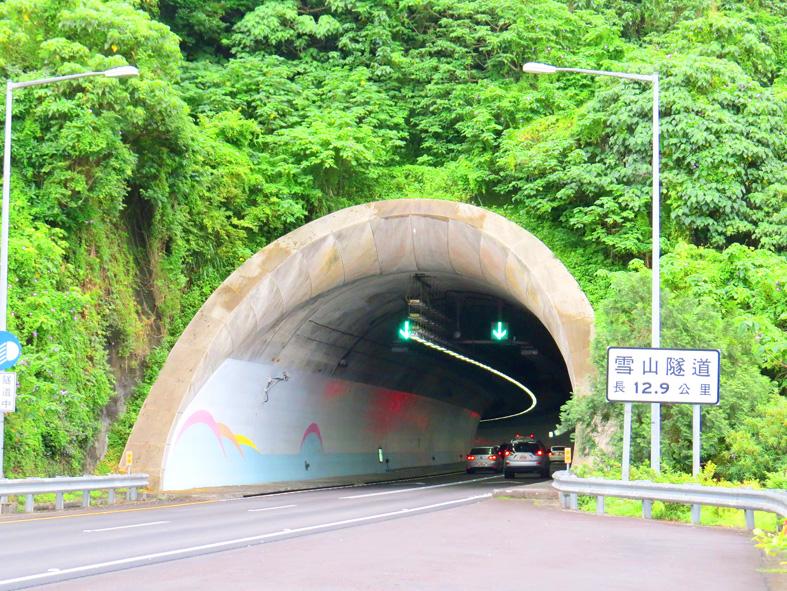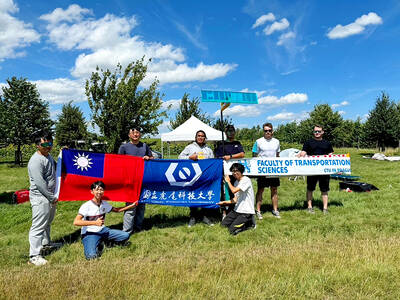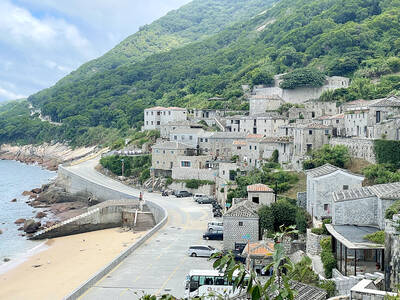The Freeway Bureau yesterday disclosed the license plate numbers of the top 10 drivers who had driven below the minimum speed limit of the Hsuehshan Tunnel on the Chiang Wei-shui Freeway (Freeway No. 5) more than a dozen times between January and September.
The minimum speed limit inside the Hsuehshan Tunnel is 70kph. To curb slow driving, the bureau has installed a warning system to detect northbound vehicles driving below 65kph and maintaining a following distance of greater than 100m.
Approximately 7.58 million vehicles drove through the northbound lanes of the Hsuehshan Tunnel from January to September, of which 75,000 were warned by the system for driving too slowly, the bureau said.

Photo: Chiang Chih-hsiung, Taipei Times
Of the 75,000 slow drivers, 15,000 were warned twice or more, it said.
Slower drivers on the northbound lanes were most often warned during the off-peak hours on weekdays, the bureau said, adding that their average driving speed was about 56kph.
On average, they maintained a following distance of 140m, it said.
“We found that the top 10 slow drivers drove below the tunnel’s minimum speed limit more than 14 times. The driver who was ranked No. 1 in this category did so 20 times,” the bureau said, adding that it did not know what prompted the drivers to consistently operate their vehicles under the speed limit.
The warning system is only used to help facilitate the flow of traffic and the data registered on the system are not used for law enforcement personnel to issue fines for contravening traffic regulations, the bureau said.
However, the system does disclose the license plate numbers of slow drivers on the freeway information electronic bulletin board in a bid to speed up the flow of traffic, it said.
Drivers operating their vehicles far below the minimum speed limit when there is no congestion on the freeway could face a fine of NT$3,000 to NT$6,000, the bureau said.

The Chinese military has built landing bridge ships designed to expand its amphibious options for a potential assault on Taiwan, but their combat effectiveness is limited due to their high vulnerability, a defense expert said in an analysis published on Monday. Shen Ming-shih (沈明室), a research fellow at the Institute for National Defense and Security Research, said that the deployment of such vessels as part of the Chinese People’s Liberation Army (PLA) Navy’s East Sea Fleet signals a strong focus on Taiwan. However, the ships are highly vulnerable to precision strikes, which means they could be destroyed before they achieve their intended

The Taiwan Experience Education Program (TEEP) has funded short-term internships in Taiwan for more than 4,500 young people from more than 40 countries since 2015, with the goal of attracting and retaining international talent, the Ministry of Education said yesterday. Fifty-five colleges launched 514 projects this year, including in fields such as semiconductors, artificial intelligence, medicine and biotechnology, green energy, and sustainability, it said. The program provides research and practical internships in Taiwan for two to six months, and offers cultural exchange and networking opportunities, the ministry said. For example, National Formosa University’s Embedded System and Autopilot Laboratory developed two solar-powered drones in

GLOBAL: Although Matsu has limited capacity for large numbers of domestic tourists, it would be a great high-end destination for international travelers, an official said Lienchiang County’s (Matsu) unique landscape and Cold War history give it great potential to be marketed as a destination for international travelers, Tourism Administration Director General Chen Yu-hsiu (陳玉秀) said at the weekend. Tourism officials traveled to the outlying island for the Matsu Biennial, an art festival that started on Friday to celebrate Matsu’s culture, history and landscape. Travelers to Matsu, which lies about 190km northwest of Taipei, must fly or take the state-run New Taima passenger ship. However, flights are often canceled during fog season from April to June. Chen spoke about her vision to promote Matsu as a tourist attraction in

Taipei resident Mu Chu-hua caught some glimpses of China’s mighty military parade on YouTube on Wednesday. As she watched hypersonic missiles roll down Beijing’s Changan Avenue and troops march in lockstep, she did not feel like they posed a threat to Taiwan. Mu, a 69-year-old retiree, said she saw the parade as simply a way for Chinese President Xi Jinping (習近平) to “say thank you to the troops.” “I thought it was quite normal,” she said. “It was very cool.” China’s military parade commemorating the end of World War II was being watched internationally for insights into Beijing’s military advances and its show